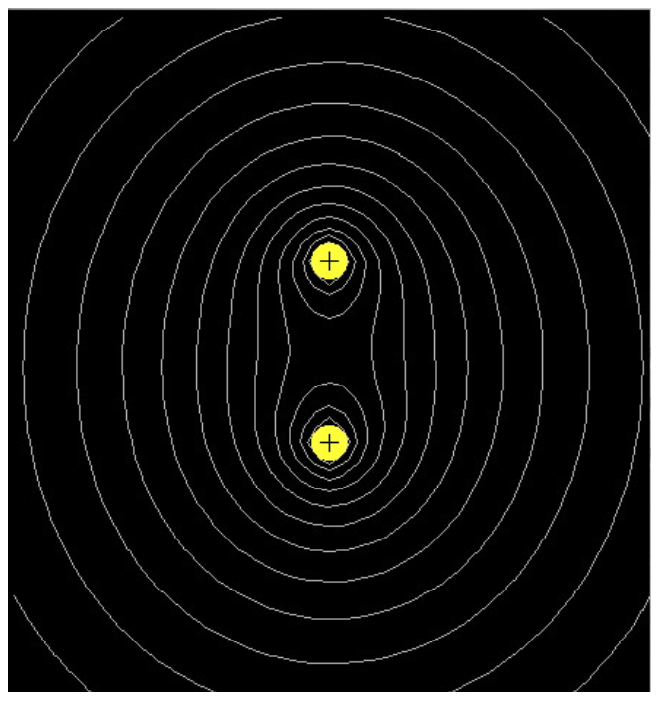
Chapter 7: Electric Potential
7.0. Overview
The final topic in our study of electrostatics is related to electric fields and their ability—their potential—to be able to move charges through space.
Let's get started!
- Electric Potential Energy
- Electric Potential
- Equipotentials
- Calculating Potentials and Fields
- Potentials and Fields for Conductors
7.1. Electric Potential Energy
Energy concepts are going to be extremely important to us as we consider the behavior of charges in electric fields.
7.1.1. Masses in gravity fields

Let's begin our development of these new concepts by considering what happens to a mass's energy as it moves through a gravity field.
Recall that a mass m released near the surface of the earth begins to move, due to the force of gravity. This can be described in two ways:
- The gravity field does Work on the object, W = Fgd, increasing its kinetic energy
- The object-earth system has gravitational potential energy Ug = mgh, which is converted to kinetic energy as the object falls.
7.1.2. Charges in electric fields
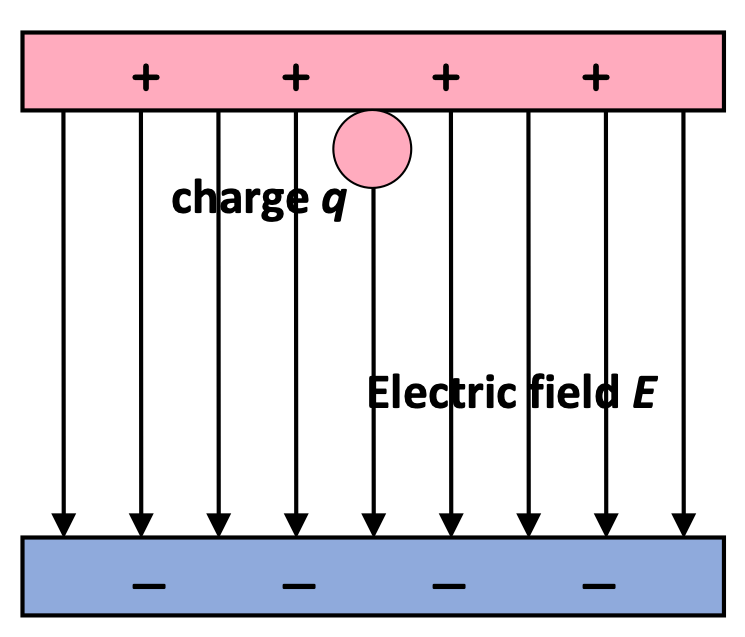
In the same way, let's consider a positive electric charge placed in an electric field pointing down. There are two ways of considering the effect of the field on the charge:
- The electric field does Work on the positive charge, W = Fed, increasing its kinetic energy.
- The charge in the electric field has electric potential energy Ue = qEd, which is converted to kinetic energy as the charge is accelerated by the field.
Where is the electric potential high for this test charge? Where is the electric potential low for this test charge? Note that a decrease in U results in an increase in K.
A charge accelerated by an electric field
A proton has a potential energy of 6.7e-15 J on the positive side of a constant 0.10 m wide electric field. At the negative side, U = 0.00 J.
- What is the magnitude of the electric field?
- After being released from rest, how fast is the proton traveling just before it arrives at the negative plate?
- We can calculate the electric field strength by analyzing the change in potential energy as the particle moves through the field.
- A simple energy analysis yields the answer:
Electric Potential Energies
Examine each of the following situations, in which a particle (pink = positive, blue = negative) is placed in an electric field. Identify whether the particle in the field is in a position of high electric potential energy or low electric potential energy.
- High electric potential energy
- High electric potential energy
- Low electric potential energy
- Low electric potential energy
In each case, the actual amount of energy will depend upon three factors: the amount of charge, the strength of the field, and the particle's position in the field relative to the low (0) potential energy.
As the particle is moved through the field, its potential energy in the field changes, as does its kinetic energy.
7.2. Electric Potential
We'd like to be able to talk about electric fields, and the energy changes that occur when charges move through those fields, without having to worry about the charges themselves.
Just as we can talk about changes in a gravity field without having to worry about an actual mass moving around in that field, we can talk about changes in energy as one moves through an electric field, without having to consider an actual charge in that field.
Definition: Electric Potential

A change in electric potential is defined as the "change in potential energy per unit charge" as one travels through an electric field.
Recall that we can determine the change of potential energy for a charge being moved through an electric field by the electric force:
If we take the Joules of energy, the work done on the particle by the field, and divide out the charge, we have the "Joules-per-Coulomb" of electric potential, a value that describes moving through the electric field from one position to another.
High electric potential is at the positive end of the electric field, with electric field lines pointing toward lower electric potential. Often the electric potential is set at 0 at the negative charge (sometimes called the "ground").
Electric Potential
A potential difference of 9.0-Volts exists between two plates.
- How much work is required to move an electron across that potential difference?
- If the plates are separate by 10.0 cm distance, what is the strength of the electric field between the plates? (Assume a constant electric field between the plates.)
- The work done by the electric field is equal to the change in potential energy, which can be calculated for a specific charge (in this case, the electron) moving across that electric potential difference.
- Based on the derivation above, and assuming the electric field is relatively constant between the closely-spaced plates:
Accelerating electrons
An electron (e-) in a TV picture tube is accelerated from rest through a potential difference of 5000 Volts.
- As the electron moves, is it accelerating from high electric potential to low electric potential? or from low electric potential to high electric potential?
- What is the change in the potential energy of the electron?
- What is the final speed of the electron?
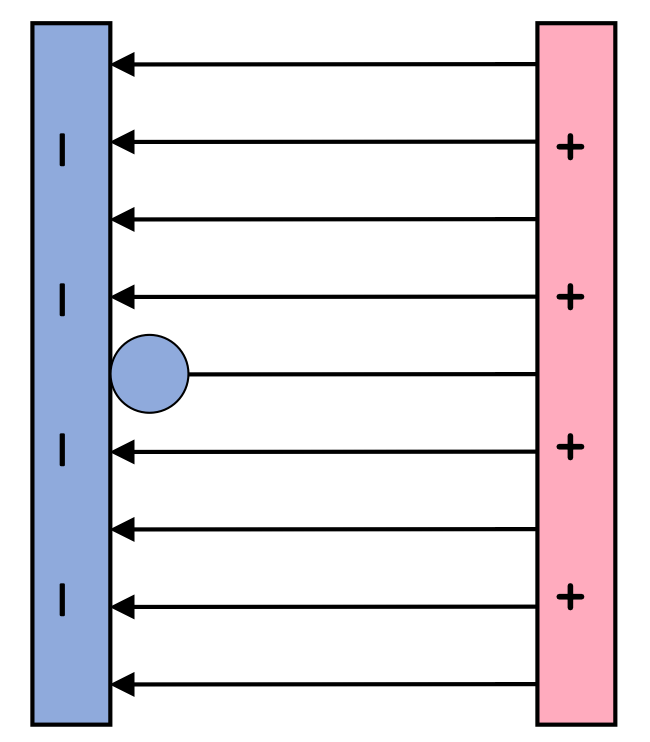 The position of high electric potential is defined as where a positive charge would have high electric potential energy, ie, the "positive side" of an electric field. Because this is a negative charge is it accelerating from the low electric potential side, the "negative side" of the electric field.
The position of high electric potential is defined as where a positive charge would have high electric potential energy, ie, the "positive side" of an electric field. Because this is a negative charge is it accelerating from the low electric potential side, the "negative side" of the electric field.If we're paying close attention to the signs here, the electron is traveling from a low electric potential to a high electric potential, so the ΔV is a positive value. In calculating with a negative electron, then, we would calculate a negative ΔU, which represents a decrease in potential energy as the electron travels. This is consistent with an increasing kinetic energy K as it accelerates.
Accelerating alpha particle
Two parallel plates, separated by a distance of 0.050 m, are charged to a voltage difference of 50.0 V.
- Calculate the magnitude of the electric field between the plates.
- What is the acceleration of an alpha particle (a helium nucleus, He2+, rest mass of 6.64e-27 kg) placed in the field?
- 1000 N/C
- Hmmmm.
7.2.1. Absolute Electric Potential
You may recall that, in developing our understanding of Newton's Law of Universal Gravitation, we considered changes in Gravitational Potential Energy for very large distances. Ultimately, we ended up setting Ug = 0 at a distance r = ∞.
With that as our reference, we could calculate the potential energy between any two masses.
In a similar fashion, we'd like to be able to define electric potential in space for a charge (or distribution of charge), relative to 0 potential at r = ∞.
Absolute Electric Potential

In the diagram shown here, for the point charge +q with the electric field shown, we can identify an electric potential at various distances r from the point charge.
The electric potential at a point in space represents the amount of energy-per-unit-charge that it takes to move a small, positive, test-charge from infinitely far away to that position.
The electric field around the positive charge +q point away from it, and results in a force being applied to a test charge, a force that increases in magnitude as the test charge comes closer to +q. For a given position in space where there is a potential of 3.0 Volts (as an example), it would take 3 Joules per unit charge (Coulumb) to move that charge to that position.
Moving charges through potential differences
A +6 μC charge in space has an electric field that extends out into infinity.
- Calculate the electric potential at a point 50 centimeters from the charge.
- How much work would it take to move a proton from infinitely far away to the position 0.50 meters away from the charge?

- Using the formula derived above:
So, for every coulomb of charge to be moved from infinity, we'll need 1.08e5 Joules of energy to move that charge.
This is the amount of work we would have to do to bring a positive charge to that position from infinity. It's also the amount of work that the field will do on the charge in applying a force and sending it off back to infinitely far away.
Note that absolute electric potential is not a vector—it doesn't point in any direction. It can have a positive or negative value, depending on the electric field. We'll examine this in the next section.
Keep in mind, too, that just as we can have multiple masses in space, we can have multiple charges in the same region of space. To determine the electric potential at any point in space, simply sum up the potentials for the individual charges relative to that point in space.
7.3. Equipotentials
Equipotentials refer to a line that can be drawn for which every point on the line has the same electric potential.
Take a look at the drawings here of equipotentials and field lines. What is the relationship between the orientation of the field lines and the orientation of the equipotentials?
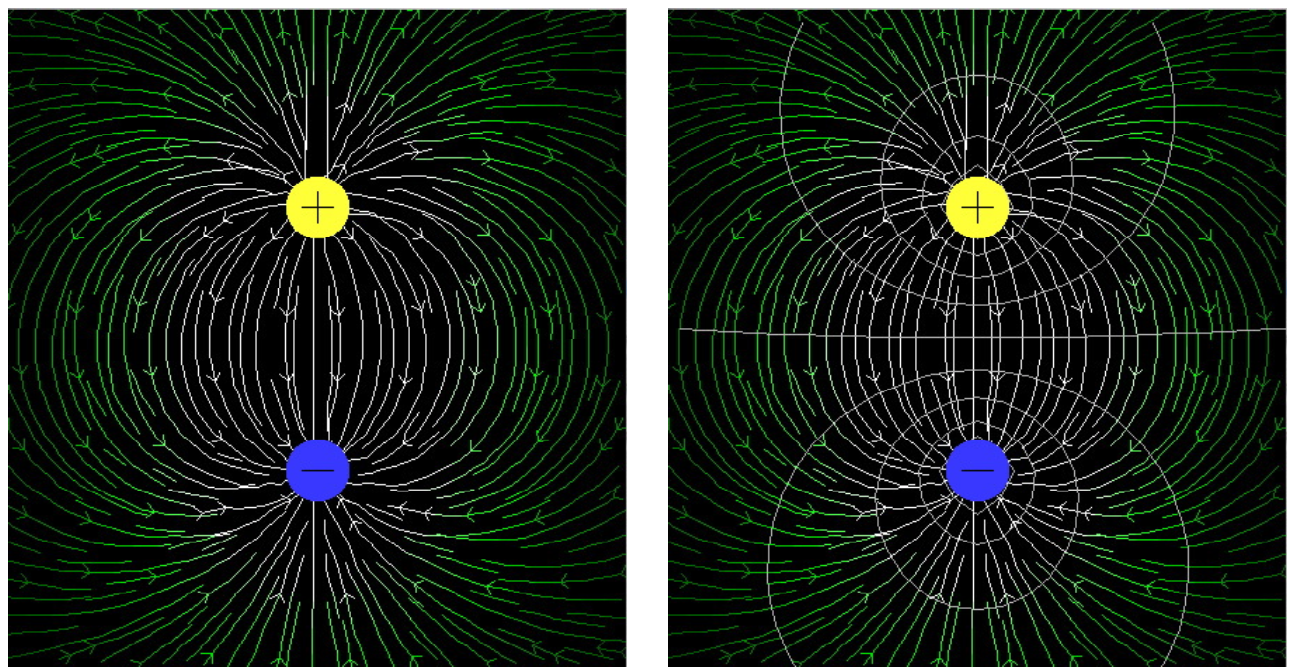
This next diagram shows this same relationship using a 3-d perspective. According to the indicated values, what it the potential difference between the positive charge and the negative charge?

7.3.1. Identifying potentials from field lines
Draw the equipotentials
Given this electric field diagram, sketch the equipotentials for a total potential difference of 7 Volts. Label your equipotentials with the voltage value for each line.
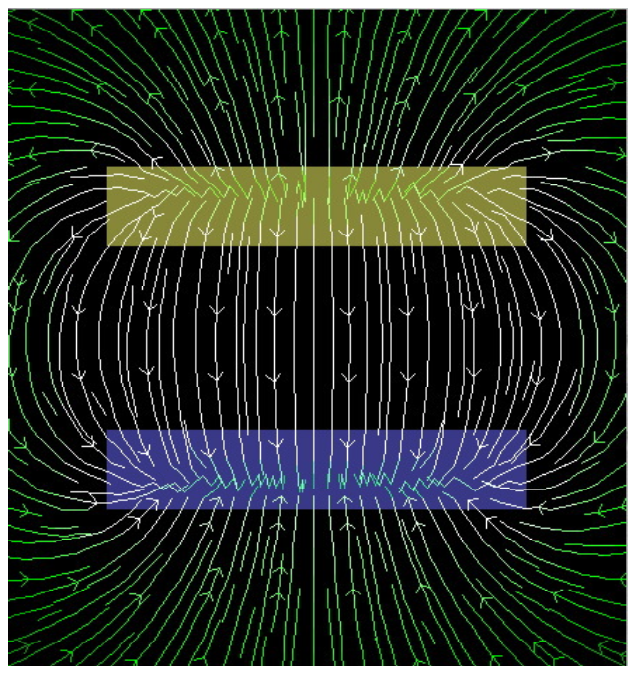
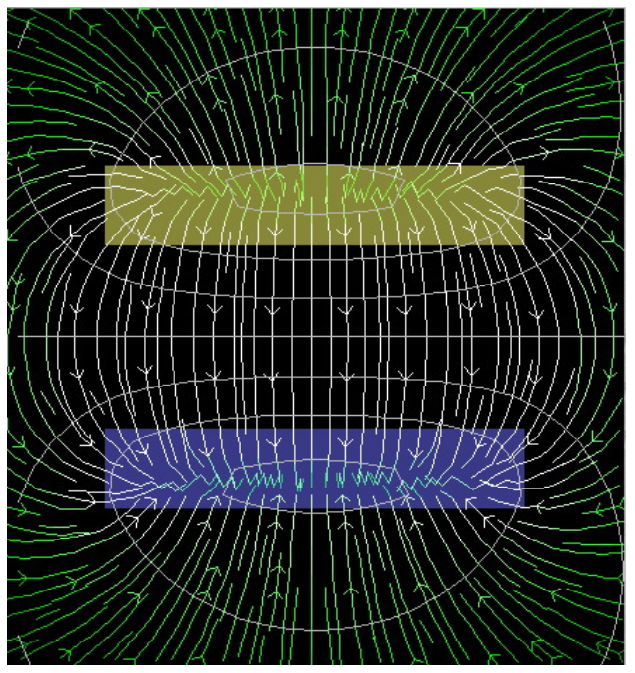
7.3.2. Identifying fields from equipotentials
Find the work done
Click on the image below to try this Physlet experiment that demonstrates the relationship between equipotentials and energy.

7.4. Calculating Potentials and Fields
We've seen how to qualitatively sketch equipotentials from field lines, and field lines from equipotentials. Now let's see if we can develop a more quantitative way of determining fields from potentials.
7.4.1. Calculating Electric Field based on potential
We've already identified that this equation describes how we can integrate through an Electric field to determine the change in potential:
We can write this in a radial form, integrating with respect to r, or along an axis, integrating with respect to x, as needed.
We can also flip this around to a derivative form, allowing us to take an electric potential function V, and differentiate it with respect to r, or x, or whatever, in order to get the function for the electric field function in that direction.
Let's see how that works with a simple example.
Electric field near a point charge
Given the fact that the electric potential near a point charge is V = k q/r, determine the electric field at position r from the charge.
This looks familiar! :)
7.4.2. Partial derivatives
It's nice to be able to take the derivative of a potential function V(r) to get the electric field in a given dimension, but what if the electric potential function V includes other dimensions? What if the function varies as a function of x, y, and z, such as V = 5x - 3x2y + 2yz2 ?
Given a 3-dimensional function, how can we find its derivative?
We can't differentiate with respect to all of the variables at the same time, so we use a partial derivative in each dimension, and then combine those to get the result.
How to solve a partial derivative
Using electric potential as an example, a partial derivative is indicated by , which indicates that the function is to be differentiated with respect to the single variable x.
The value of that derivative is determined by taking the derivative with respect to the one variable while keeping the other variables constant.
By taking the derivative with respect to each variable in turn, the components of the vector can be determined.
Let's use this strategy to solve a problem.
Electric field from a potential function
In a region of space, the electric potential is given by the function V = 5x - 3x2y + 2yz2.
- Find functions for the electric field components in this region.
- Determine the magnitude of the field at the point P that has coordinates (1, 0, -2) m.
- Taking the derivative of this function with respect to x, then y, and then z, we get
- Using the given values of x = 1, y = 0, and z = -2, we substitute into the expressions just derived to get:
7.4.2.1. The del operator
This operation of taking the derivative of a vector quantity by performing partial derivatives of the vector components is referred to with the "del" operator, an upside-down triangle.
As we've already mentioned, applying these partial derivatives to a function allows us to determine the vector components of the result. In the case of using the derivative of a potential function V to get the electric field components of E:
Electric field in space
If the electric potential is constant in some region of space, what can you conclude about the electric field in that region?
E = -dV/dr, so if the potential is constant in space, there is no dV, and therefore, no electric field in that region.
7.4.3. Calculating potentials
If you need to calculate the electric potential for a point in space—the "amount of energy per unit charge" that it takes to move from infinity to get to that point in space—there are three strategies for doing so. Which strategy will be best for a given problem depends on your situation.
- For identifying the potential V at a distance r from a point charge, use
- For a continuous charge distribution where the distribution is known, you might use
- For a continuous charge distribution with a known Electric field, you might use the integral
Let's solve some problems!
Electric potential along the axis of a hoop
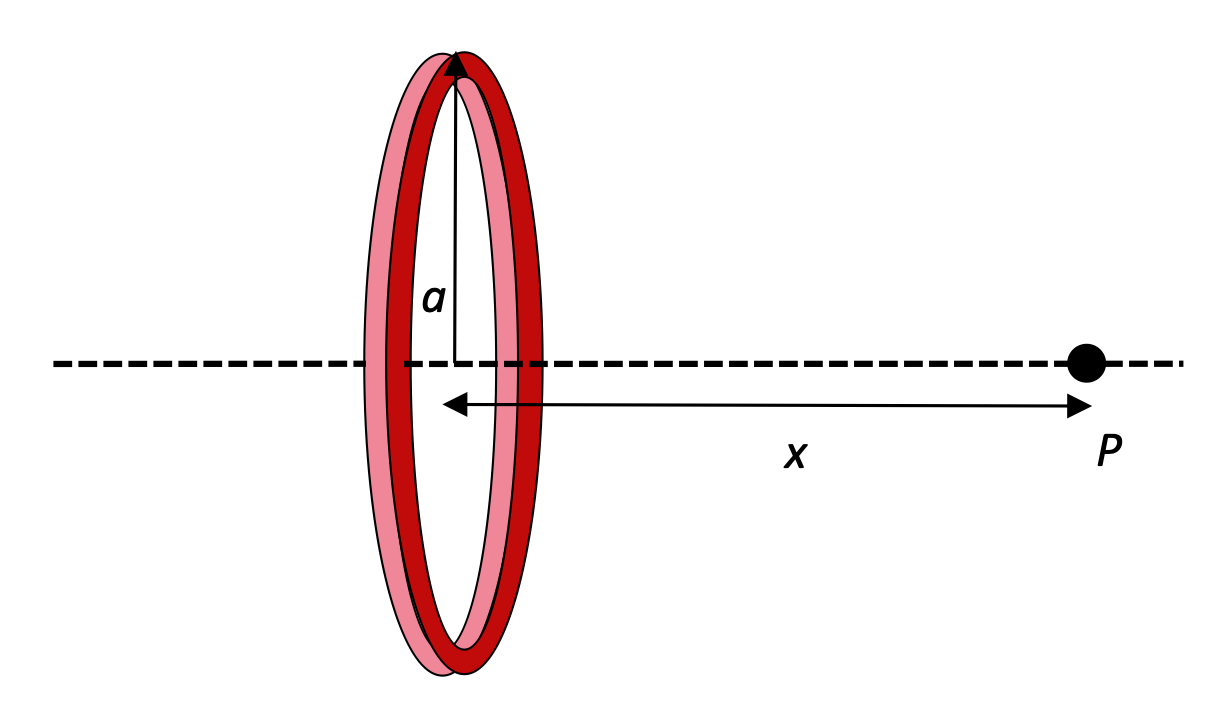
Determine the electric potential for a hoop of charge +Q and radius a, at a distance x along the x-axis, as shown.
Electric field based on potential
Based on your results from the previous problem, determine the electric field E at this same position.
Potential near an insulating sphere
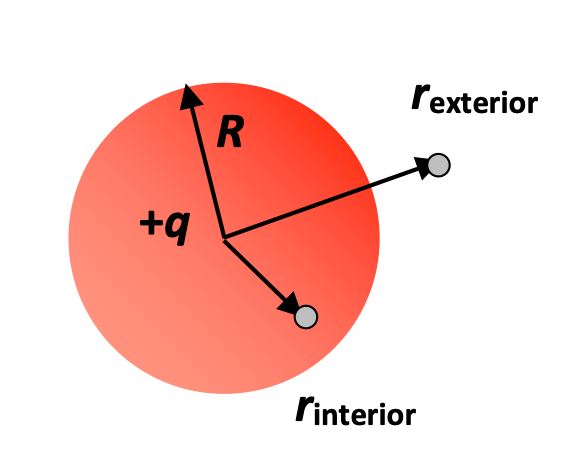
An insulating solid sphere of radius R has a uniform positive charge density w/ total charge +q.
- Find the electric potential at a point outside the sphere, r > R. (Take potential to be 0 at r = ∞.)
- Find the potential at a point inside the charged sphere, r < R.
- What are the electric field and electric potential at the center of the uniformly charged sphere?
- Based on knowing the electric field outside the charge distribution:
- To find the potential inside the sphere, we have to take into account the work that we've already done moving from infinitely far away (the answer to (a) above) as well as the additional work necessary to push the charge through the interior of the sphere. This requires knowing the electric field in there.
- At the center of the sphere, the electric field is 0. We can explain this either by invoking Gauss's Law with a Gaussian surface of volume 0 and no net charge inside, or by considering the symmetry of the sphere, and all the dE vectors due to all the dq charges cancel out.
Just because the electric field is 0, that doesn't meet that it didn't take a lot of work to move a test charge from infinity to that location. We can identify the electric potential at the center by setting r = 0 in the equation from the previous problem.
7.5. Potentials and Fields for Conductors
What we already know about E fields and charged conductors:
- In a conductor, charges reside on the surface.
- Just above the surface of the conductor, the E field is perpendicular to the surface, and has a magnitude E = σ/ε0.
- In the conductor, E = 0. If this weren't the case, charges would be moving, and we wouldn’t have a static situation.
What can we conclude about the electric potential V in and around a (charged) conductor?
- V is constant everywhere along the surface of a conductor. (ΔV = - ∫ E · ds, but E is perpendicular to surface, as ds changes along the surface.)
- The surface of any charged conductor (in equilibrium) is an equipotential surface. Furthermore, since E = 0 inside the conductor, we conclude that the potential is constant everywhere inside the conductor, and equal to its value at the surface.
Note that it's ΔV = 0, not V itself.
Graphs of a charged conductor

Draw a graph of E vs. r and V vs. r for a charged conducting sphere of radius a.


Charged conducting cavities

Explain what happens with fields and potential with this positively-charged conducting cavity?
There is an electric field and electric potential on the exterior of the charged cavity.
Inside the cavity, any two points on the inner surface of the shell are at the same potential, so there is no potential difference anywhere in there. This implies that there is no electric field in there.
If you want to protect a circuit or electronic device from electric fields, enclose them in a conductor!
Dr. Megavolt [YouTube]



